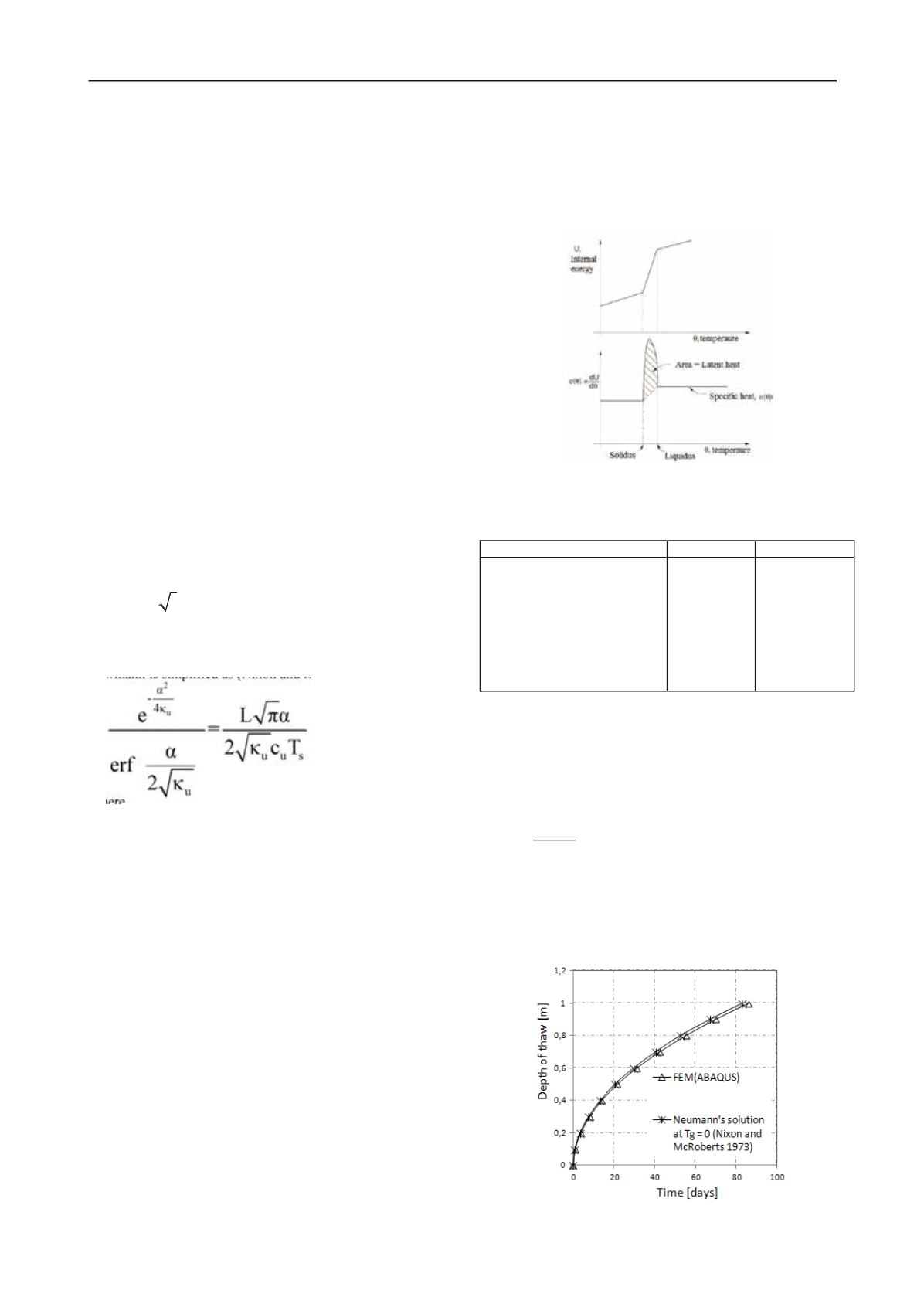
858
Proceedings of the 18
th
International Conference on Soil Mechanics and Geotechnical Engineering, Paris 2013
Proceedings of the 18
th
International Conference on Soil Mechanics and Geotechnical Engineering, Paris 2013
1.1
Thermal properties of soils
The principle of heat transfer in frozen soils is governed by
conduction. The effect of radiation is negligible. The heat
transfer process by convection is also minimal for fine-grained
soils with very low permeability. During freezing, some of the
water film is removed and ice crystals partially fill the voids
between soil particles. This reduces the conductivity path for
soil with low moisture content. In the contrary, experimental
tests at high moisture content and densities showed increased
conductivities in the frozen state, since ice fills the pores
completely (Becker et al. 1992, Penner et al. 1975). The thermal
conductivity of ice is more than four times greater than that of
water (Penner 1970). In the thawing process of frozen soils, the
amount of water in the frozen state plays a significant role in the
development of pore water pressure. Some assumptions are
made in the analyses in this paper such as the frozen soil is fully
saturated, the heat transfer mechanism is only by conduction,
and the thermal conductivity of the soil is isotropic.
2 ANALYTICAL AND NUMERICAL SOLUTIONS FOR
THE THAWING PROCESS
Nixon and McRoberts (1973) studied on the thawing rate of
homogeneous frozen soil subjected to a step increase in
temperature from (Tg) in the ground to (Ts) at the surface. The
analythical formulla relating the depth of thawing to the square
root of time, based on Newmann’s solution (Carslaw and Jaeger
1959) is shown in Eq. 1.
X
t
= a
(1)
Where X is the depth of thaw, t is the time and
∝
is a
constant determined from Newman’s rigorous equation. When
the ground temperature is close to zero, the equation from
Newmann is simplified as (Nixon and McRoberts 1973);
(2)
Where
α
is the constant in Eq. 1.
κ
u
is the diffusivity of the unfrozen soil (
/
.
K
u
is the thermal conductivity of unfrozen
. .
⁄
).
c
u
is the volumetric heat capacity of unfrozen
. ⁄
).
L is the volumetric latent heat of the soil
⁄
).
is the applied constant surface temperature
).
is the error function.
2.1
Finite element analysis
In the thawing process, temperature has a direct effect on the
water flow field in saturated and unsaturated soils which
undergo drainage and consolidation upon thawing. As a result
of this, the heat flow and fluid flow equations are coupled
mathematically through the phase change component and an
optimization procedure is incorporated into the computational
scheme (Harlen 1973). In a saturated soil, the latent heat
absorbed/released on the thaw-freeze front has a major impact
on the rate of thawing. In the numerical scheme, the latent heat
can be defined in two ways (Xu et al., 2009). It can be included
in the heat conduction equations or it can be defined by using
temperature dependent specific heat as shown in Figure (1). To
ensure the accuracy of this method, the time increments or the
maximum temperature change in each increment should be
limited to assure the energy balance and a uniform temperature
field is defined as initial condition. In this analysis, the latent
heat is assumed to be released between -0.1
and 0
. Thermal
properties of the soil, listed in Table (1) are used both for the
analytical analysis and numerical simulation. For the numerical
input, temperature dependent thermal properties are used for the
frozen and thawed states. A frozen soil is almost impermeable
and a very low permeability,
1 x 10
m/s
, is used for
the ground temperature less than zero degree Celsius.
Figure 1. Specific heat, latent heat definition (Abaqus FEA, 2011)
Table 1: Input parameters
Parameters
Unit
Value
Thaw conductivity
Consolidation coefficient(
)
Permeability(k)
Unit weight(
γ
)
Latent heat of soil(volumetric)
Latent heat of water
Surface temperature
Ground temperature
J/m.s.
0
C
m
2
/s
m/s
kg/m
3
J/m
3
J/kg
0
C
0
C
1.05
1.1 x 10
-6
2.5 x 10
-7
1820
1.73 x 10
8
3.34 x 10
5
12
0
The conductivity of the frozen soil is assumed to be twice
that of the thawed soil. Similarly, the stiffness of the frozen soil
is assumed to be 100 times that of the stiffness in the thawed
state. The amount of frozen water is directly related to the
moisture content. For fully saturated soils, a reasonable
assumption of void ratio can be made from the following
relationship.
s
* G e
S
w
=
(3)
Where
is the void ratio,
is the water content, G
s
is the
specific gravity of the soil, and
is the degree of saturation
(
1
for fully saturated condition). In reality, the void ratio of
soils varies greatly upon freezing and thawing. The permeability
of the soil can be defined as a function of void ratio in the
numerical simulation.
Figure 2. Comparison of analytical solution and numerical simulation


